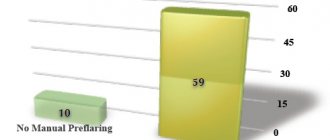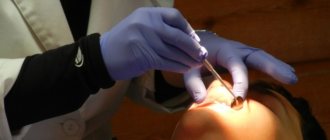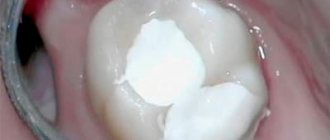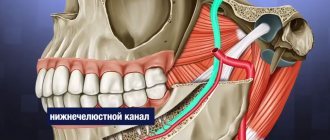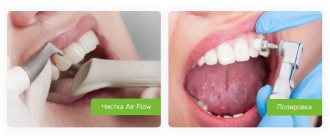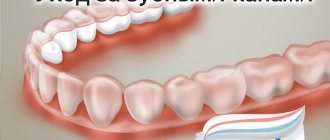Resorcinol-formalin method of root canal filling
This method involves the transformation of the pulp or its decay in the impassable part of the root canal into a plastic-like aseptic strand that is not subject to dissolution or decay under the influence of microflora and tissue fluid.
First, the carious cavity is prepared, the tooth cavity is opened and endodontic access is created. After this, the patency of the root canals is determined. Well-passable canals are mechanically and medicinally treated and sealed.
Pregnation with a resorcinol-formalin mixture is carried out in three to four visits. When carrying out the resorcinol-formaldehyde method, the contents of the root canal are impregnated with a resorcinol-formaldehyde mixture, which, after using a catalyst, polymerizes into phenol-formaldehyde plastic. As a result, the pulp, together with microorganisms, appears to be immured in this glass-like mass that does not decay. During the polymerization process, this mass shrinks, moving away from the canal walls and apical foramen, so the resorcinol-formalin method does not guarantee sealing of the canal lumen. To reduce shrinkage, the passable part of the canal should be filled with resorcinol-formalin paste.
After the resorcinol-formalin method, the tooth turns pink; when it penetrates the apical foramen, the resorcinol-formalin mixture causes irritation of periodontal tissue.
In 1912, Dr. Albrecht proposed a method of filling infected tooth canals using formaldehyde saturated with resorcinol (resorcinol is a phenol derivative). The method is based on the bactericidal and mummifying properties of this mixture, due to which the decay of incompletely removed pulp is stopped. The mixture slowly hardens in the tooth canals, which was thought to seal them. The method turned out to be cheap, easy to use and widely used. In our country, during Soviet times, it was used in the treatment of chewing teeth (molars) in 84% of cases, and continues to be used now by many dentists, symbolizing poor quality treatment in professional circles.
The fact is that many years of research have cast doubt on the effectiveness of the resorcinol-formalin method and have proven that its use is dangerous for the body . Formalin and resorcinol are toxic substances that have carcinogenic and mutagenic properties. Once in the canals of the tooth, formaldehyde (the active ingredient in formalin) gradually spreads throughout the body - it was found in the liver and kidneys, in the lungs, and in the muscles. It is quite possible that in many cases dangerous diseases were provoked by dental treatment using resorcinol-formalin. Therefore, all progressive dentists have unanimously said “no” to this method of treating root canals for more than 20 years.
For about ten years, the patient may not experience pain from the treated tooth, but this does not mean that everything is fine. The hidden inflammatory process continues, and cysts form on the roots of the tooth. Due to the toxic effect of the resorcinol-formalin mixture, the gums gradually atrophy, exposing the roots of the tooth. The result is that in 75% of cases repeated intervention is required. Retreatment or removal of such a tooth is associated with many difficulties . On x-rays, the “resorcinol-formalin” canals of the tooth appear empty, which makes diagnosis difficult. The tooth becomes brittle and begins to crumble . The color of the tooth always changes - it becomes pinkish or dark. Teeth do not whiten after treatment with the resorcinol-formalin method. As a result, the doctor who has to re-treat the tooth cannot guarantee a positive outcome even when using modern effective methods . And, the saddest thing is that “resorcinol-formalin” teeth, as a rule, cannot be used as a support for a prosthesis , and if you choose between a fixed bridge and a removable prosthesis, you will have to make a decision in favor of a removable prosthesis with all its inconveniences and disadvantages.
In Russia, the leaders of the Endodontic Section of the Dental Association decided not to recommend the resorcinol-formalin method for clinical use, and also to petition for its exclusion from the training program at dental faculties. However, this method is still used today. Its “survivability” is apparently due to the cheapness and low solvency of the majority of our fellow citizens, and, in addition, their unjustifiably indifferent and frivolous attitude towards their health. Therefore, when faced with the need for root canal treatment, always ask your dentist if he is going to use the resorcinol-formalin method. And if the answer is yes, we recommend finding another doctor.
(based on Internet sources)
-What analogues of this method of treating pulpitis and periodontitis are available in our clinic?
— One of the effective modern methods is the method of lateral condensation of gutta-percha. In the West, it is used to treat tooth canals in approximately 80% of cases.
The essence of the method is that the tooth canal, after removal of the pulp and mechanical treatment with special instruments, is filled with thin and flexible rods (pins) of gutta-percha in combination with a special hardening paste. Gutta-percha is the dried sap of the gutta-percha tree, which grows in Brazil and Malaysia. Plastic gutta-percha pins can be used to fill a tooth canal of any thickness and curvature; they do not collapse inside the canals. The paste, used in combination with gutta-percha pins, has an antiseptic effect and hermetically seals the tooth canal. All drugs used are non-toxic and do not irritate tooth tissue. So the treatment turns out to be quite effective and can significantly extend the life of the tooth.
Silver plating method for root canal filling
The silvering method involves soaking the impassable part of the root canal with silver nitrate. After the restoration of silver, a thin film of metallic silver (“silver mirror reaction”) is deposited on the walls of the micro- and macrochannels, “burying” the microflora in the thickness of the dentin. As a result of the interaction of silver with pulp proteins, silver albuminates are formed, which “preserve” the pulp, turning it into an aseptic strand that is not subject to putrefactive decay. In addition, the presence of silver in the canal, which has a long-term antiseptic (more precisely, oligodynamic) effect, prevents the growth of microflora and the development of inflammatory complications from the apical periodontium.
Impregnation using the silvering method is also carried out in 3-4 visits.
Silvering method is an outdated procedure
The silvering method is an outdated procedure, which for some reason is still carried out in a number of public and private dental clinics. What is silver plating? This is the treatment of teeth with a special composition based on silver nitrate, as a result of which a layer of restored silver remains on the surface of milk teeth, which should stop the development of caries, because silver has an antimicrobial effect. But, unfortunately, this is not the case.
Minuses:
- Silvered teeth will turn black. Because of this, children often begin to feel embarrassed first about their smile, and then about themselves as a whole.
- Silvering does not eliminate the cause of caries. It was believed that this method could prevent its further development, but this does not always work. As a result, most often silvering simply masks the problem.
- It does not help with advanced caries; moreover, if silver preparations come into contact with the pulp, they cause it to die.
- If it gets on the gum, a burn to the mucous membrane is possible.
- It is difficult to track the dynamics of the carious process under the film layer.
Possible alternatives to silvering are remineralization therapy, fluoridation, and ICON treatment.
Combination of silvering method and resorcinol-formalin method
To increase the efficiency and reliability of impregnation methods, it was proposed to combine the silver plating method and the resorcinol-formalin method. In this case, the silvering method is first carried out, in which the walls of the micro- and macro-channels are covered with a film of metallic silver. Then impregnation is carried out with a resorcinol-formalin mixture, as a result of which the pulp in the impassable part of the root canal turns into an aseptic plastic-like strand that is not subject to dissolution or decay under the influence of microflora and tissue fluid.
What is the danger?
The main reason for such a long existence of the resorcinol filling method is its low cost, ease of use and effectiveness. But in many countries around the world this method is strictly prohibited and has not been used for more than 70 years. Dentists practicing today in European countries and the USA do not even know about its existence.
But, in the USSR, this method was the main one in the treatment of dental canals, and some dentists still use it. So why can’t resorcinol-formalin paste be used as a filling material for dental canals and pulp?
It's all about the composition of the paste. The formaldehyde and resorcinol it contains are hazardous toxins that have been proven by many years of research to have carcinogenic and mutagenic properties.
Formaldehyde, which is part of the filling agent, penetrates from the tooth canal into the blood and spreads throughout the body, reaching the kidneys, lungs, liver and other organs. When these substances settle in them, they can cause the development of cancer.
Another negative side of resorcinol-formalin is that a tooth, once treated with this substance, is practically not subject to re-treatment. As the practice of using this method shows, the paste does not always completely fill the dental canals. Therefore, there remains a risk of resumption of the inflammatory process in the hermetically sealed canal.
Cysts and ulcers form on the root of the tooth.
Almost 50% of cases of teeth treated with resorcinol require re-treatment, which cannot be performed for the following reasons:
- X-rays show canals filled with paste as voids, so there is no possibility of an accurate diagnosis, and, therefore, there is no confidence in the correct treatment strategy.
- After treatment with resorcinol, the tooth becomes pathologically brittle and crumbles under dental instruments;
- After resorcinol, it is impossible to fill the canal again, as hypercementosis develops - cement deposition in the root area. The root grows firmly into the bone, and filling it can cause serious complications, as well as removal.
Not only is treatment after resorcinol extremely problematic, but prosthetics using a resorcinol-formalin tooth is also impossible.
The fact is that fragile teeth, due to treatment with this method, cannot be used as a support for orthodontic dentures.
Mummification of the contents of the impassable part of the root canal
The term “mummification” in dentistry refers to the prevention of microbial decomposition of the pulp by impregnating it with potent antiseptics (thymol, camphor, iodoform, cresol, parachlorophenol, etc.). For this purpose, a cotton swab moistened with potent, slowly dissolving antiseptics, or a paste containing mummifying substances, is placed into the tooth cavity at the mouth of the root canals, and the tooth is sealed. This method is currently practically not used due to its low efficiency.
Advantages and disadvantages
The resorcinol-formalin method is widely used due to the following factors:
- ease of preparation of the medicinal mixture;
- confidence in the safety of the reagent at the time of development of the method;
- simple treatment technique;
- accessibility due to the low price of the composition.
Among the disadvantages are:
- the need for re-intervention in more than 75% of cases after just a few years;
- a complication of diagnosis, since in X-rays the channels filled with resorcinol-formalin composition look hollow;
- increased fragility and fragility of dentin after exposure to formaldehyde and resorcinol;
- detected harm to the patient's health.
Harmful components
Studies have confirmed that exposure to resorcinol-formalin mixture poses both local and general health risks. After hardening, due to the disabling of the nerve, the pain disappears, but this does not mean the complete destruction of all pathological foci. The body is simply no longer capable of a natural reaction in this place - pain.
After placing the resorcinol-formalin composition into the canal, slow gum atrophy occurs, the soft tissues near the tooth subside, and the root neck is exposed. Due to the fact that formalin is very hygroscopic, it draws fluid from the bone tissue, so the dentin and root become brittle and brittle. By the time tangible signs of inflammation appear, it is difficult to re-treat, since the fragility of the tissue prevents it from being properly dissected, and there is a high probability that it will crumble in the process. For the same reason, removal is also complicated.
Substances included in the resorcinol-formalin composition cause darkening of dentin and enamel. Most often there is a pink or brown tint. It is impossible to whiten such a tooth using existing methods, since the darkening is concentrated not on the surface, but in the very structure of the bone tissue. In severe cases, destruction of connective tissues, paresthesia of the facial nerves innervating the lower jaw, chronic infections inside the maxillary sinuses, etc. are possible.
Premolars treated in this way cannot be used as a support for installing a permanent denture - this is hampered by increased fragility, so you have to choose uncomfortable removable dentures.
But the mixture has the greatest harm on the general condition of the body. This harm cannot be assessed objectively, since the consequences are strongly separated from the moment of treatment and have not previously been associated with each other. However, numerous experiments and studies have confirmed how extensively resorcinol-formalin solution affects health. Formaldehyde, which is the active ingredient of the composition, is found in the kidneys, lungs, and muscle fibers. The main blow falls on the reproductive system, respiratory organs, the central nervous system is depressed, the skin and vision are affected.
Stages of treatment
The resorcinol-formalin treatment method is carried out in several stages. It requires a minimum of three visits to the dental office.
First visit
All manipulations that are performed using this method on the first day, in the case of baby teeth, are recommended to be carried out without injection anesthesia. Sometimes parents ask to numb the area if the child is very afraid and has a low pain threshold. In adults, local anesthesia is used, since the roots go deeper and are treated on a larger scale.
The tooth cavity is opened using a drill. A resorcinol-formalin mixture is prepared from a few drops of formalin and a small amount of resorcinol powder. The paste is mixed until smooth using a metal spatula. Before applying the paste, the tooth is isolated from saliva and thoroughly dried, and then a solution is placed into the canal. Depending on the size of the cavity, you need to place 1-4 drops there. The mixture is compacted using special tools, and the excess is removed. Then the procedure is repeated.
At the end of the first stage, the dentist installs a temporary artificial dentin filling and schedules a follow-up visit in a day or two. This time is enough for the substance to take effect.
Second visit
Since the nerve has already been killed by the second visit, anesthesia is not used. The temporary filling is opened, the medicine placed for the first time is removed along with the pulp, and the paste is again applied to the empty root canals. The cavity is sealed with artificial dentin.
Third visit
The temporary filling is opened. At the final stage, a catalyst - chloramine or caustic soda - is added to the paste to resorcinol-formalin to speed up disinfection inside the cavity. The canal is tightly filled with this composition, and then the tooth is filled with a permanent filling. The coronal part is restored while maintaining the anatomical shape.
In rare cases, the dentist decides that three fillings are not enough, then a fourth visit is scheduled, and a permanent filling is installed only for the fourth time.
Possible complications of root canal filling
The main cause of complications during the procedure is the thinning of the walls of the tooth root. Among the complications are:
- Perforation of dental canals. Typically, holes in the mouths of the canals appear during the process of removing old filling material, preparing a bed for a central pin, or screwing in an artificial tooth root. Perforation may be caused by poor instrument fixation or excessively curved channels. Also, to avoid complications, the doctor must correctly calculate the force of impact. To prevent the appearance of holes in the dental canals, it is important to prevent clogging of the cavity with dentine particles, using a special anti-curvature technique for cleaning root cavities. Its main technique is the implementation of reciprocating movement of the tool.
- Broken tool. Usually this complication is a consequence of cleansing channels that are too narrow and curved. The risk of fracture also increases in the following cases: when using damaged files, failure to comply with the dimensions of the tool, its untimely replacement, violation of operating conditions, and applying too much force. In order to avoid breaking off the instrument, the doctor must strictly follow the procedure protocol and also use endolubricants (chemicals to facilitate mechanical processing).
- Excessive expansion of physiological narrowings in the apical or middle zone of the canal. If too much dentin tissue is removed, the tooth’s resistance to mechanical damage will become significantly lower. Excessive expansion of the canals is a consequence of the use of instruments with low flexibility and an aggressive tip, as well as excessive root curvature. As a precaution, the physician should take into account the anatomical structure of the canals, use the correct instruments and be careful.

